In the southern pine region of the southeastern United States, stands of loblolly and slash pine occupy approximately 30.7 and 10.4 million acres, respectively (5). These forests are among the world's most productive, producing about 16% of global industrial wood. Of the industrially owned lands, greater than 50% have been established in plantations. Intensification of plantation establishment by non-industrial private landowners has also occurred as a source of primary or secondary income (e.g., timber, pine straw). The growth of these even-aged plantations can be influenced by a wide spectrum of silvicultural treatments such as site preparation, understory competition control, fertilization and the use of genetically improved seedlings (11, 21). It follows that Coastal Plain forests in the southern United States are among the most intensively managed in the world. Figure one documents the progression of silvicultural treatments used in this region over time and their impacts on volume yields at harvest and rotation lengths.
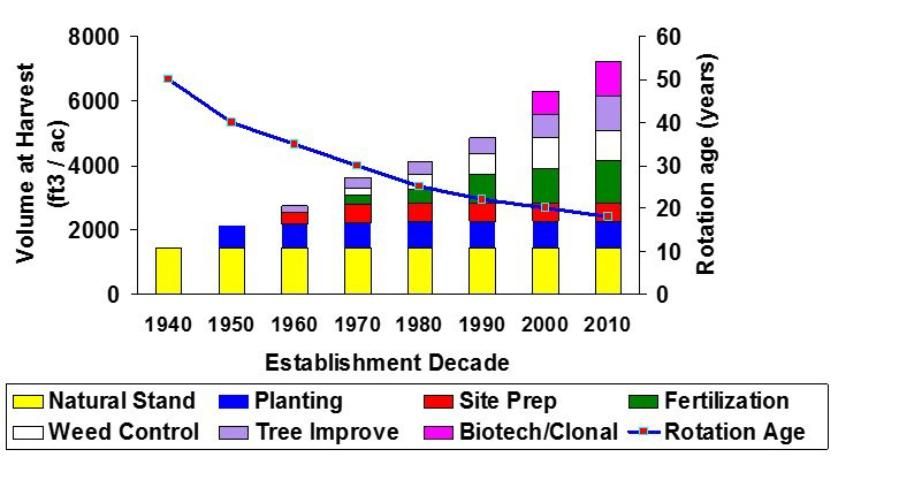
Credit: Redrawn from 7
Soils supporting southern pine stands in the South tend to be infertile and nutrient additions are often required to achieve optimum rates of production (1, 6, 9, 18). Early site occupancy and the development of a large and functioning canopy leaf area represents an essential strategy for enhancing pine productivity, and correcting nutrient deficiencies through fertilizer additions is an important silvicultural tool for achieving that objective (4). Phosphorus (P) plus nitrogen (N), and P alone, are the nutrient elements that tend to be the most chronically limiting in southern pine stands. In some cases, potassium (K) and other nutrients may limit southern pine growth after N and P demands have been met (3, 8, 15). For example, micronutrient deficiencies have been documented (manganese [Mn], Copper [Cu]) in southern pine stands that were managed intensively using N + P fertilization and understory competition control treatments (12, 20).
Fertilization represents an important silvicultural treatment that forest landowners can apply to increase financial returns through rapid growth rates and shorter pine crop rotations. In southern pine stands, fertilizers are most commonly applied near the time of planting (0-4 years) and at mid-rotation (6–15 yr) (1, 5, 9). In 2007, Albaugh et al (1) reported that over 16 million acres of southern pine forests were fertilized between 1969 and 2004. The peak application year occurred in 1999, when 1.59 million acres were fertilized (2). In 2014, approximately 1,000,000 acres received fertilizer additions, mostly by the forest industry (3). Levels of financial return associated with fertilizer applications depend on the magnitude and duration of growth responses, costs associated with fertilizer investment, and product values. It should be noted that not every forest will respond to fertilization, with one study reporting 221 of 850 fertilized plots (26%) showing no response (Zhao et al. 2016). Unresponsive stands often have high background fertility, other limitations (e.g. water) to tree growth, or intense competition from understory plants (Zhao et al. 2016).
Effective operational use of fertilizers requires diagnostic systems, used individually or in combination, which accurately identify site nutrient status, needs, and potential responsiveness. Numerous diagnostic techniques including soil classification, visual criteria, leaf area development, foliage and soil testing, and growth and yield models can aid decisions about whether or not to fertilize. All have operational advantages and limitations because of differences in reliability, costs, and technical skills required for application.
This publication describes and classifies soils of the southeastern Coastal Plain region and specifically addresses issues of fertility, growth-limiting nutrients, and fertilizer recommendations for southern pines. As a diagnostic tool, soil descriptions represent one of the most common and useful approaches for characterizing and classifying sites as potential candidates for forest fertilization.
Major Land Areas and CRIFF Soil Groups
Soil groupings, based on easily recognizable features, are used to identify sites where available nutrient supplies are low, or where other site factors (e.g., moisture availability) influence growth. Soil classification tends to be one of the most easily applied diagnostic tools for assessing the need for fertilizer additions to forests. To understand the general distribution of forest soils and their fertility in the South, it may be helpful to consider the major land areas of the Coastal Plain Region, and a soil classification system developed in the 1980s by the Cooperative Research in Forest Fertilization (CRIFF) program at the University of Florida. This classification system is now widely used as a basis for stratifying forestland for fertilization and other silvicultural treatments, including species selection.
The eight CRIFF soil groups (A–H, Figure 2) are defined using soil drainage, and texture and depth of the subsurface soil layers. Table 1 defines the nature of each soil group in relation to major land areas. Slash pine plantations are commonly established on, but not limited to, CRIFF A, B, C, and D group soils. Suitable sites for loblolly pine plantations are commonly found on CRIFF A, B, C, E, and F group soils.
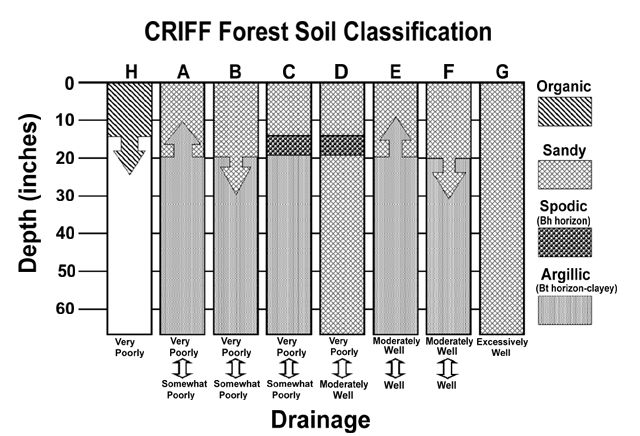
Average stand response to fertilizers differs significantly among soil groups. In some cases, simply knowing the soil type (e.g., CRIFF A) is adequate for making fertilization decisions and estimating response. In other cases, responses may vary significantly within a soil group, indicating that additional information is necessary to increase prediction accuracy.
For the most part, all the information necessary to categorize an area into an appropriate CRIFF soil group can easily be obtained in the field or from existing USDA-NRCS soil surveys. In the field, it is necessary to dig several holes across a particular area using a soil auger or shovel. Information collected on drainage and estimated thickness and type of soil horizons can be used in conjunction with Figure 2 to determine the applicable CRIFF soil group. Distinguishing characteristics of each soil group in relation to fertility are described in greater detail below.
Alternatively, if a county soil survey has been completed for your area, information contained in the document can be used directly to classify the site according to its CRIFF soil group. Key information to look for in the soil description would be drainage class, presence and depth of the Bt or argillic (i.e., clayey layer) horizon and/or spodic (Bh) horizon (i.e., weakly cemented organic hardpan). For example, soil descriptions for the Pomona and Orangeburg series are shown in Table 2. The Pomona series would be classified as a CRIFF C group soil because it is poorly drained and the profile description shows the presence of both a Bh and Bt horizon. By contrast, the Orangeburg series is an E group soil because it is well drained and the Bt horizon is found within 20 in. of the surface. Official USDA-NRCS soil profile descriptions for all soil series in the United States can be easily accessed from the following world-wide web location: https://soilseries.sc.egov.usda.gov/osdname.asp.
In addition, a smartphone application ("app") is available as a free download for both iPhone and Android users. The app, SoilWeb, combines online soil survey information with the smartphone's GPS capabilities and is particularly useful in the field because it provides soil survey information in a mobile form.
If the soil-series name is known, Table 3 can be used directly to classify it according to CRIFF group. Table 3 lists most forest soils that would commonly support pine and hardwood vegetation in Florida; it does not include, however, soil series associated with tidal marshes. It should be noted that many of the soil series listed in Table 3 are also found in the Coastal Plain of other southern states (e.g., AL, MS, GA, SC, and NC) and, therefore, the CRIFF classification would be consistent across this region. Figure 3 was also developed to assist in field recognition of soil drainage classes using understory plant indicators.
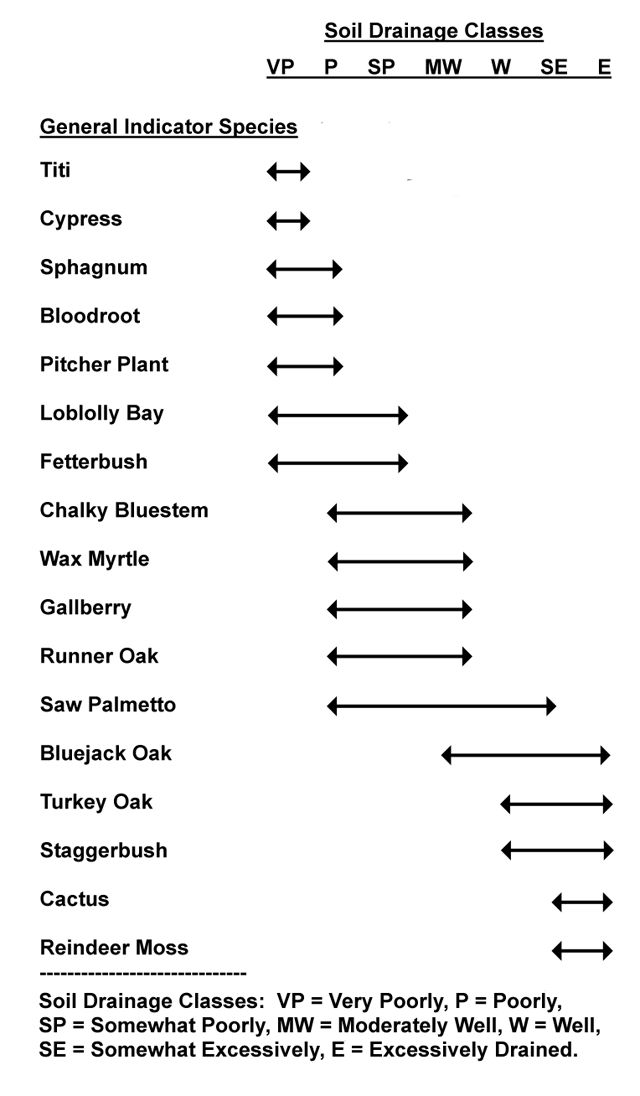
CRIFF A and B Soils (Very Poorly to Somewhat Poorly Drained—Bays and Wet Savannas)
These soils are typically found in nearly level depressions, stream terraces, and broad wet flats. Wiregrass and pitcher plants, some hardwoods and fair to poor growth of pine occur natively on these soils, commonly referred to as wet savannas. In most instances, excessive soil moisture and lack of available P slow pine growth. Most of these very poorly to somewhat poorly drained soils are flooded from 5 to 30 days, one or more times during the growing season, with the water table ranging from 6 to 20 inches below the surface much of the remaining time. Because they formed under impeded drainage, these soils can contain 4–8% organic matter in the surface horizon and most are extremely acid and dull (shades of gray and grayish-brown) in color. The primary symptom of P-deficiency in pine is very slow growth, often no more than 40–45 feet in height after 25 years. The crowns are also very sparse and contain few branches with short, yellowish needles.
The CRIFF A and B group soils are distinguished primarily by the depth to the clayey subsoil (i.e., Bt or argillic horizon). An argillic horizon is found within 20 in. of the surface for A group soils and deeper than 20 in. for B group soils (Figure 2). In some cases, the B group soils may not have a clayey subsoil within 60 in. of the surface. CRIFF A group soils, such as the Bayboro, Bladen, Coxville, Leaf, Myatt, Pansey, Rains, and Wahee series, have a dark gray to black fine sandy loam surface, with dark brown to grayish finer-textured material within 20 in. of the surface (Table 3). These wet soils with clay near the surface (commonly classified as Ultisols) tend to be among the most P-deficient in the South. It should be noted, however, that certain A group soils with high base status in the subsoil might not be as nutrient deficient (e.g., Meggett series). These soils are typically classified as Alfisols and can be identified in the field by presence of fragmented shells in the subsoil and species such as cabbage palm in the understory. Similarly, the CRIFF B group soils are responsive to P fertilizer additions, but because of their relatively high organic matter content, they have a moderate capacity to retain P. Hence, fertilizer responses from P additions at planting, although highly beneficial on B group soils, may not be as dramatic as found on A group soils. Representative soil series belonging to the CRIFF B group would include Leefield, Pelham, Plummer, Rutledge, and Surrency (Table 3). In addition, if sites were previously fertilized with P, then expected growth responses would typically be lower than for sites with no prior fertilizer history (i.e., residual soil fertility).
Young Stands
Because of excessive soil moisture, single-pass or double-pass bedding is recommended site preparation before planting on both A and B group soils. Fertilization with P or a combination of P and nitrogen (N) is recommended at, or near the time of planting (e.g., 0–5 yrs old). Fertilizer responses can be strong, often making the difference between a commercial stand and no stand at all (Figure 4). For example, yield differences of two- to three-fold at age 25 years have been documented where fertilizer additions have been made at time of planting (8, 10, 18). Delaying fertilizer applications on such sites with no prior fertilizer history will cause significant growth losses. Approximately 25–50 lbs/ac of elemental P and 40–50 lbs/ac of elemental N are recommended application rates. If a combination of N and P is desired, diammonium phosphate—DAP (18-46-0) or monoammonium phosphate (MAP; 11-52-0) represent excellent fertilizer materials, providing some N as well as P. For example, an application of 250 lbs/ac DAP at planting would provide an elemental equivalent of 45 lbs/ac N and 50 lbs/ac P.
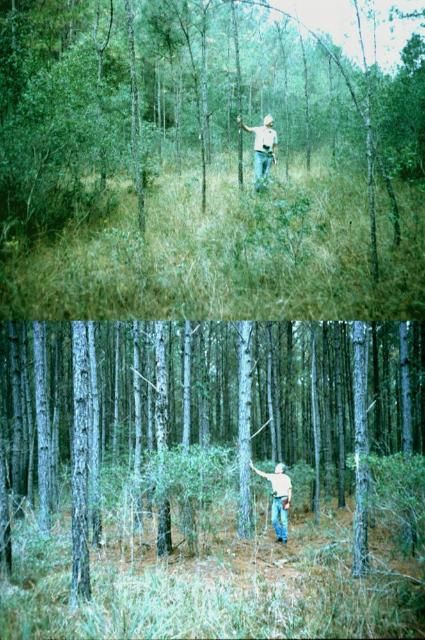
Nitrogen applied alone is not recommended at time of planting because P is often more limited on these soils. Also, applications of N alone could create site nutrient imbalances, increase competition from weeds, and contribute to early growth suppression of pines. When used in conjunction with N + P fertilization, however, herbaceous weed control treatments can enhance pine growth responses on these soils. For example, results from a University of Florida experiment showed that the volume of 8-yr-old loblolly pine growing on A group soils averaged 713 ft3/ac when no fertilizer or weed control treatments were applied at planting (14). In contrast, volume was doubled (1430 ft3/ac) when herbaceous weed control was combined with the N + P fertilizer rates recommended above. Volume for the fertilizer and herbaceous weed control treatments, when applied alone, averaged 1202 ft3/ac and 803 ft3/ac, respectively. These growth responses to weed control and fertilization are created by reductions in competition for soil nutrients between pines and understory plants, and increases in foliage development and interception of sunlight by the pines.
Established Stands
Fertilizer requirements for older stands are based on the same principal as young stands. However, it is often more difficult to predict the need for fertilizers in older stands because deep root penetration may allow absorption of nutrients from subsoil horizons, even though surface horizons are low in available nutrients. Surface layers of organic debris (e.g., pine needles) also serve as a nutrient reservoir, releasing nutrients as the material slowly decomposes (16,17). Nevertheless, deficiencies of N and P are most pronounced after the crowns "close" because decomposition processes slow down and the nutrients become "tied up" in the stem, bark, branches, roots and foliage of the pines and understory plants. Fertilization with a combination of N and P are recommended for such stands (13). Application rates of approximately 150–200 lbs/ac elemental N plus 25 lbs/ac elemental P will often result in growth responses averaging 50 ft3/ac/yr or more (6). These responses normally last from about 6–8 years. Common fertilizer sources would include DAP, MAP, and urea (45-0-0). Mid-rotation fertilizer applications that include urea are generally recommended for all soils between January and May to avoid volatilization losses of N. Commercial urease inhibitors are also available to reduce volatile N losses from urea (22).
CRIFF C and D Soils (Very Poorly to Moderately Well Drained—Flatwoods Spodosols)
The flatwoods and associated soils represent one of the most extensive groups of forest in the Coastal Plain. The somewhat poorly to moderately well drained C and D group soils developed in coarse-textured sediments (acidic, sand to loamy sand texture) low in native fertility. Nitrogen and P fertilizer additions commonly elicit significant growth response in pines. Understory plants useful for recognizing these soils include saw palmetto, gallberry, blueberries, St. John's-wort, runner oak, and wiregrass. Dogfennel is not generally found growing on Spodosols. Typically, the density of understory plants increases as you progress from the moderately well drained soils (e.g., light to moderate understory vegetation density; 3–4 ft. tall) to the very poorly drained soils (e.g., heavy understory density; 5–7 ft. tall).
Flatwoods soils are found on nearly level to gently sloping flat areas where the water table rises to within 5 to 20 in. of the soil surface from 1 to 4 days, one or more times each growing season. Their sandy surface horizon ranges in color from light gray (salt and pepper like) on moderately well drained soils to black (with a greasy texture) on very poorly drained soils. The surface horizon overlays a bed of leached grayish to white sand (E horizon). Below the E horizon is a reddish brown to black spodic horizon (Bh horizon), which is characteristic of both the C and D group soils. The spodic horizon represents a zone where iron, aluminum, and organic matter have accumulated. In some cases the spodic horizon may become weakly cemented when dry, causing some impedance to root development. The primary basis for distinguishing the C group soils is the presence, below the spodic horizon, of an argillic (clayey) horizon (Figure 2). Representative soils series belonging to the CRIFF C group would be Mascotte, Olustee, Pomona, Sapelo, and Wauchula (Table 3).
Conversely, soils that characterize the CRIFF D group (i.e., spodic horizon, but no argillic (clayey) horizon) would include the Immokalee, Leon, Lynn Haven, Mandarin, Pomello, and Pottsburg series (Table 3).
Young Stands
Similar to A and B group soils, the C and D soils are commonly bedded prior to planting. After the wet savannas (A and B group soils), the second highest priority for fertilization should probably be given to the flatwoods. Fertilizer and herbaceous weed control treatments, applied alone or in combination at time of planting, can significantly increase pine growth on C and D group soils. These soils tend to be deficient in both N and P, although levels of K and sometimes micronutrients (Mn, Zinc (Zn), Cu) are also in marginal supply (Figure 4) and growth responses have been similarly documented (3, 12, 20), albeit less frequent than for N and P. Broadcast application of approximately 40–50 lbs/ac elemental N and 25 to 50 lbs/ac elemental P represents the most common treatment for these soils if they had not previously received fertilizer additions (19). Pre-plant chemical site preparation and herbaceous weed control treatments can enhance the probability and magnitude of growth responses derived from fertilizer applications. Loblolly pine has generally been more responsive than slash pine to fertilizer and weed control treatment on these soils. For example, 8th year volume response of loblolly pine on C and D group soils averaged 32% when 45 lbs/ac N + 50 lbs/ac P was applied at planting (14). Growth responses to the combination treatment of fertilizer + herbaceous weed control averaged 52%. Slash pine treatment responses were generally smaller in magnitude and averaged 10% for the combined treatment.
If deficiencies of K and micronutrients are suspected, on the basis of soil or foliar tests, a mixed fertilizer such as 10-10-10 + micronutrients should be applied at rates of 500–600 lbs/ac rather than the DAP treatment. Subacute deficiencies of Mn and Cu on CRIFF B, C and D group soils appear to be easily corrected from a single application of a needed micronutrient at time of planting, and it may suffice for the entire rotation (12).
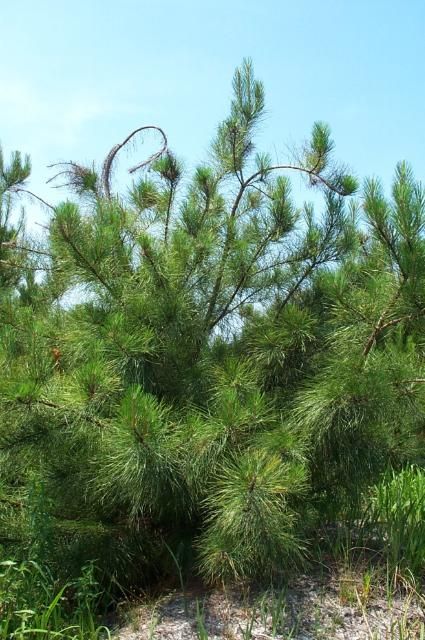
Established Stands
Older southern pine stands (post crown closure) growing in the flatwoods are commonly deficient in both N and P. Growth responses average approximately 55 ft3/ac/yr when both N and P are applied at elemental rates of about 150–200 lbs N/ac and 25–50 lbs P/ac. Note that the application of N or P alone is not recommended on these soils because growth responses have been largest and most consistent to the combined N + P treatment (Figure 6). Fertilizer responses on these soils commonly persist for 6–8 years. The most common fertilizer sources used for this prescription are a combination of DAP or MAP and urea. Where K is deficient, it should be included in the fertilizer program at rates ranging from 50 to 80 lbs K/ac. Common K fertilizer sources would include KCl (muriate of potash), KSO4 or a mixed fertilizer such as 20-20-20. A foliar test should be used to confirm suspected deficiencies of these elements, including micronutrients.
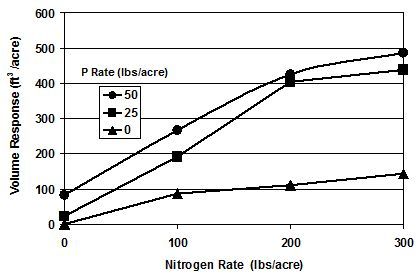
CRIFF C and D Soils (Very Poorly to Moderately Well Drained—Flatwoods Spodosols)
The flatwoods represent one of the most extensive groups of forest soils in the Coastal Plain. The somewhat poorly to moderately well drained C and D group soils developed in coarse-textured sediments (acidic, sand to loamy sand texture) low in native fertility. Nitrogen and P fertilizer additions commonly elicit significant growth response in pines. Understory plants useful for recognizing these soils include saw palmetto, gallberry, blueberries, St.John's-wort, runner oak, and wiregrass. Dogfennel is not generally found growing on Spodosols. Typically, the density of understory plants increases as you progress from the moderately well drained soils (e.g., light to moderate understory vegetation density; 3–4 ft. tall) to the very poorly drained soils (e.g., heavy understory density; 5–7 ft. tall).
Flatwoods soils are found on nearly level to gently sloping flat areas where the water table rises to within 5 to 20 in. of the soil surface from 1 to 4 days, one or more times each growing season. Their sandy surface horizon ranges in color from light gray (salt and pepper like) on moderately well drained soils to black (with a greasy texture) on very poorly drained soils. The surface horizon overlays a bed of leached grayish to white sand (E horizon). Below the E horizon is a reddish brown to black spodic horizon (Bh horizon), which is characteristic of both the C and D group soils. The spodic horizon represents a zone where iron, aluminum, and organic matter have accumulated. In some cases the spodic horizon may become weakly cemented when dry, causing some impedance to root development. The primary basis for distinguishing the C group soils is the presence, below the spodic horizon, of an argillic (clayey) horizon (Figure 2). Representative soils series belonging to the CRIFF C group would be Mascotte, Olustee, Pomona, Sapelo, and Wauchula (Table 3).
Conversely, soils that characterize the CRIFF D group (i.e., spodic horizon, but no argillic (clayey) horizon) would include the Immokalee, Leon, Lynn Haven, Mandarin, Pomello, and Pottsburg series (Table 3).
Young Stands
Similar to A and B group soils, the C and D soils are commonly bedded prior to planting. After the wet savannas (A and B group soils), the second highest priority for fertilization should probably be given to the flatwoods. Fertilizer and herbaceous weed control treatments, applied alone or in combination at time of planting, can significantly increase pine growth on C and D group soils. These soils tend to be deficient in both N and P, although levels of K and micronutrients (Mn, Zinc (Zn), Cu) are also in marginal supply (Figure 4) and growth responses have been similarly documented (3, 12, 20), albeit less frequent than for N and P. Broadcast application of approximately 40–50 lbs/ac elemental N and 25 to 50 lbs/ac elemental P represents the most common treatment for these soils if they had not previously received fertilizer additions (19). Pre-plant chemical site preparation and herbaceous weed control treatments can enhance the probability and magnitude of growth responses derived from fertilizer applications. Loblolly pine has generally been more responsive than slash pine to fertilizer and weed control treatment on these soils. For example, 8th year volume response of loblolly pine on C and D group soils averaged 32% when 45 lbs/ac N + 50 lbs/ac P was applied at planting (14). Growth responses to the combination treatment of fertilizer + herbaceous weed control averaged 52%. Slash pine treatment responses were generally smaller in magnitude and averaged 10% for the combined treatment.
If deficiencies of K and micronutrients are suspected, on the basis of soil or foliar tests, a mixed fertilizer such as 10-10-10 + micronutrients should be applied at rates of 500 – 600 lbs/ac rather than the DAP treatment. Subacute deficiencies of Mn and Cu on CRIFF B, C and D group soils appear to be easily corrected from a single application of a needed micronutrient at time of planting, and it may suffice for the entire rotation (12).
Established Stands
Older southern pine stands (post crown closure) growing in the flatwoods are commonly deficient in both N and P. Growth responses average approximately 55 ft3/ac/yr when both N and P are applied at elemental rates of about 150–200 lbs N/ac and 25–50 lbs P/ac. Note that the application of N or P alone is not recommended on these soils because growth responses have been largest and most consistent to the combined N + P treatment (Figure 6). Fertilizer responses on these soils commonly persist for 6–8 years. The most common fertilizer sources used for this prescription are a combination of DAP or MAP and urea. Where K is deficient, it should be included in the fertilizer program at rates ranging from 50 to 80 lbs K/ac. Common K fertilizer sources would include KCl (muriate of potash), KSO4 or a mixed fertilizer such as 20-20-20. A foliar test should be used to confirm suspected deficiencies of these elements, including micronutrients.
CRIFF E and F Soils (Moderately Well to Well Drained—Uplands)
These soils are found in upland areas and range from relatively deep, moderately well-drained sands to well-drained loamy sands and sandy clays. Both the E and F group soils tend to be bright in color. The E group soils have a loamy sand to sandy loam surface that is underlain by a red to yellow fine-textured (clayey) subsoil within 20 in. of the surface (Figure 2). Conversely, soils of the F group also have a sandy surface layer, but the sandy clay horizon is found deeper than 20 in. Note that this same surface-subsurface horizon distinction is also used to delineate between the CRIFF A and B soils. Hence, in a general sense, the E and F soils represent an upland corollary to the A and B soils. However, the landscape position and brighter soil colors are reflective of much better internal drainage in these soils compared to the wet savannas.
Representative soils of the CRIFF E group include the Angie, Clarendon, Dothan, Faceville, Goldsboro, Marlboro, Norfolk, Orangeburg, Ruston, and Tifton series (Table 3). Because of their relatively high content of clay material, they have a good capacity to retain moisture and nutrients and are excellent loblolly pine sites. They are also good agricultural soils, and many existing stands were established on abandoned farmland, much of which had been seriously eroded. The Blanton, Bonifay, Fuquay, Lucy, Stilson, Troup, and Wagram series are representative of the F group soils (Table 3). These soils generally have a low capacity to retain water, but they have reasonably good moisture relations because of their topographic position. Although generally considered good forest soils, often they are used for pastures, field crops and vegetables if fertilizers are applied to offset their inherently low fertility. For southern pines, both of these soil groups tend to be naturally deficient in N and P. However, "first generation" plantations established on former agricultural sites (e.g., Conservation Reserve Program plantings) generally produce vigorous plantations because of high residual soil fertility.
Young Stands
These upland soils may receive combinations of mechanical tillage and chemical site preparation treatments. Chemical site preparation treatments offer an advantage over mechanical treatments by reducing the potential for soil compaction and erosion. Broadcast applications of 40–50 lbs/ac elemental N and 25–50 lbs/ac elemental P (56–112 lbs/ac P2O5) would represent a common fertilizer prescription at time of planting. As with the other soil groups, the efficacy of fertilizer additions on southern pine growth are enhanced when combined with a herbaceous weed control treatment during the first growing season. For example, when compared to untreated plots, 8th year loblolly pine volume on E group soils averaged 33% more on plots receiving 45 lbs/ac N + 50 lbs/ac P, and 53% more on plots that received the same fertilizer treatment + herbaceous weed control (14).
Established Stands
Nitrogen and P tend to be the most limiting nutrients for loblolly pine on upland sites, although K and micronutrient deficiencies may also exist. Foliar analysis and general inspection of the canopy leaf area is recommended to delineate deficient areas among older stands (post crown closure). Where a deficiency is indicated, elemental application rates of 200 lbs N/ac and 25–50 lbs P/ac (56–112 lbs/ac P2O5) are recommended. DAP, MAP, and urea are common fertilizer sources for these soils. Where K is deficient, it should be included in the fertilizer program at elemental rates ranging from 50 to 80 lbs K/ac. Common K fertilizer sources would include KCl (muriate of potash), KSO4, or a mixed fertilizer such as 20-20-20. Growth responses of loblolly pine on upland soils is consistently better when a combination of N + P is used than when either element is applied alone. On responsive sites, especially those that have a well-developed, shallow, clayey subsoil, volume gains due to fertilization can range from 70–90 ft3/ac/yr and persist for 6 to 8 years.
CRIFF G Soils (Excessively Drained—Sandhills)
Extensive areas of deep sands, with little soil profile development, occur in north Florida, Georgia, and the Carolina sandhills (Figure 2). These soils often formed on former sand dunes and beach ridges. Longleaf pine, turkey oak, bluejack oak and wiregrass are dominant native species. Sand pine and longleaf pine are recommended for use in reforestation on these soils in Florida. The Alpin, Candler, Chipley, Kershaw, Lakeland, and Tavares soil series are representative of the G group, and are deep, coarse-textured, droughty, and low in nutrient reserves (Table 3). G-group soils require unique management practices that conserve organic matter. Water deficits generally limit pine productivity and responses to fertilizers. Therefore, these soils are not well suited for intensive pine management that includes fertilizer applications. In comparison to the CRIFF A-F soils, only minimal silvicultural expenditures can be justified on deep, sandhill sites.
CRIFF H Soils (Very Poorly Drained—Depressions)
Soils of the H group (Figure 2) are typically found in isolated, very poorly drained depressions throughout the savannas and flatwoods (e.g., cypress ponds or strands, bottomlands along rivers). They contain high levels of organic matter in the surface horizon, with little or no sand or clay present. The organic soils have a greasy texture and are often referred to as peats, mucks or bays. Representative soils belonging to the CRIFF H group would include the Brighton, Dorovan, Lauderhill, Pamlico, and Tomoka series. Excessive wetness and frequent flooding, due to landscape position, limit their potential for intensive pine plantation management. Forest fertilization is rarely recommended. Providing or maintaining suitable seed sources encourages reliance on low intensity management and natural regeneration of pine and hardwoods for these sites.
Summary
Large gains have been made in the South over the last several decades in identifying responsive sites to forest fertilization. This circular characterizes forest soils of the lower Coastal Plain region and presents fertilizer recommendations for the various CRIFF groups. Site classification is central to the wise use of fertilizers in forest stands and the development of cost-efficient, biologically sound fertilizer prescriptions requires integration of site, stand, and economic considerations. As with any silvicultural treatment, specific conditions may cause results to deviate from those reported here. Therefore, forest managers and landowners should use the relationships and recommendations presented here as general guides.
Acknowledgements
This publication presents new information and also combines and updates materials formerly contained in University of Florida Bulletin 744 (1975): Fertilizer Recommendations for Pines in the Southeastern Coastal Plain of the United States by W.L. Pritchett and J.W. Gooding, and Soil Science Fact Sheet SL-57 (1988) Forest Soils of Florida: Useful Groupings for Forestry Purposes by E.A. Hanlon and K.R. Munson. The authors of these original publications are gratefully acknowledged.
References
Albaugh, T.J., H.L. Allen and T.R. Fox. 2007. "Historical patterns of forest fertilization in the southeastern United States from 1969 to 2004." South. J. Appl. For. 31:129–137.
Albaugh, T.J., T.R. Fox, J.L. Stape and R.A. Rubilar. 2010. Fertilizer survey – a summary of operational forest fertilization practices. Forest Productivity Cooperative, North Carolina State University, Virginia Polytechnic Institute and Universidad de Concepcion. 2 p.
Carlson, C.A., T.R. Fox, H.L. Allen, T. J. Albaugh, R.A. Rubilar, and J.L. Stope. 2014. "Growth responses of loblolly pine in the southeast United States to midrotation applications of nitrogen, phosphorus, potassium and micronutrients." For. Sci. 60:157–169.
Colbert, S.R., E.J. Jokela, and D.G. Neary, 1990. "Effects of annual fertilization and sustained weed control on dry matter partitioning, leaf area, and growth efficiency of juvenile loblolly and slash pine." For. Sci. 36: 995–1014.
Dickens, E.D., D.J. Moorhead, and B. McElvany. 2003. "Pine plantation fertilization." Better Crops 87: 12–15.
Fox, T.R., H.L. Allen, T.J. Albaugh, R. Rubilar, and C.A. Carlson. 2007. "Tree nutrition and forest fertilization of pine plantations in the southern United States." South. J. Appl. For. 3:5–11.
Fox, T.R., E.J. Jokela, and H.L. Allen. 2007. "The development of pine plantation silviculture in the southern United States." J. Forestry 105: 337–347.
Jokela, E.J. 2004. Nutrient management of southern pines. In: Dickens, E.D., Barnett, J. P., Hubbard, W.G. and Jokela, E.J. (eds) Slash Pine: still growing and growing! Proceeding of the Slash Pine Symposium, USDA Forest Service General Technical Report SRS-76, pp. 27–35.
Jokela, E.J., H.L. Allen, and W.W. McFee. 1991a. Fertilization of southern pines at establishment. p. 263–277. In M.L. Duryea and P. Dougherty (ed.) Forest regeneration manual. Kluwer Acad. Publ., Dordrecht, the Netherlands.
Jokela, E.J., R.B. Harding, and C.A. Nowak. 1989. "Long-term effects of fertilization on stem form, growth relations, and yield estimates of slash pine." For. Sci. 35:832–842.
Jokela, E.J., T.A. Martin and J.G. Vogel. 2010. "Twenty-five years of intensive forest management with southern pines: Important lessons learned." J. For. 108: 338–347.
Jokela, E.J., W.W. McFee, and E.L. Stone. 1991b. "Micronutrient deficiency in slash pine: response and persistence of added manganese." Soil Sci. Soc. Am. J. 55:492–496.
Jokela, E.J., and S.C. Stearns-Smith. 1993. "Fertilization of established southern pine stands: Effects of single and split nitrogen treatments." South. J. Appl. For. 17:135–138.
Jokela, E.J., D.S. Wilson, and J.E. Allen. 2000. "Early growth responses of slash and loblolly pine following fertilization and herbaceous weed control treatments at establishment." South. J. Appl. For. 24:23–30.
Kyle, K.H., L.J. Andrews, T.R. Fox, W.M. Aust, J.A. "Burger, and G.H. Hansen, 2005. Long-term impact of drainage, bedding, and fertilization on growth of loblolly pine (Pinus taeda L.) in the Coastal Plain of Virginia." South. J. Appl. For. 29:205–214.
Polglase, P.J., N.B. Comerford, and E.J. Jokela. 1992a. "Mineralization of nitrogen and phosphorus from soil organic matter in southern pine plantations." Soil Sci. Soc. Am. J. 56:921–927.
Polglase, P.J., E.J. Jokela, and N.B. Comerford. 1992b. "Nitrogen and phosphorus release from decomposing needles of southern pine plantations." Soil Sci. Soc. Am. J. 56:914–920.
Pritchett, W.L., and N.B. Comerford. 1982. "Long-term response of phosphorus fertilization on selected southern Coastal Plain soils." Soil Sci. Soc. Am. J. 46:640–644.
Subedi, P., E.J. Jokela, J. G. Vogel, and T.A. Martin. 2014. "Inter-rotational effects of fertilization and weed control on juvenile loblolly pine productivity and nutrient dynamics." Soil Sci. Soc. Am. J. 78:S152-S167,
Vogel, J.G. and E.J. Jokela. 2011. "An examination of micronutrient limitations in two young managed southern pine stands planted on Florida spodosols." Soil Sci. Soc. of Am. J. 75:1117–1124.
White, T.L, and M.L. Duryea. 1997. Genetically Improved Pines for Reforesting Florida's Timberlands. Cir 1190. Gainesville: University of Florida Institute of Food and Agricultural Sciences.
Zerpa, J.L., and T.R. Fox 2010. "Controls of volatile ammonia losses from loblolly pine plantations fertilized with urea in the southeast USA." Soil Sci. Soc. Am. J. 75:257–266.
Zhao, D., Kane, M.B., Teskey, R.O., Fox, T.R., Albaugh, T.J., Allen, H.L., Rubilar, R.A., 2016. Maximum response of loblolly pine plantations to silvicultural management in the southern United States. For. Ecol. Manage., 375, 105-111.